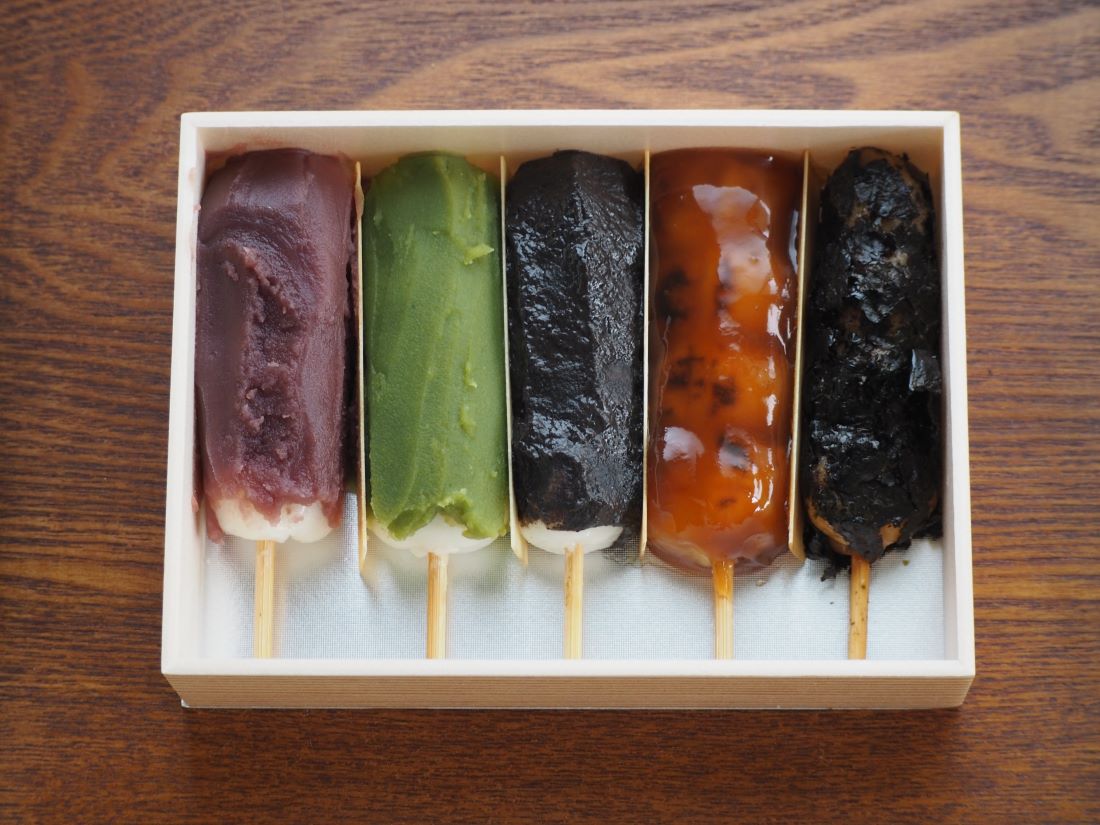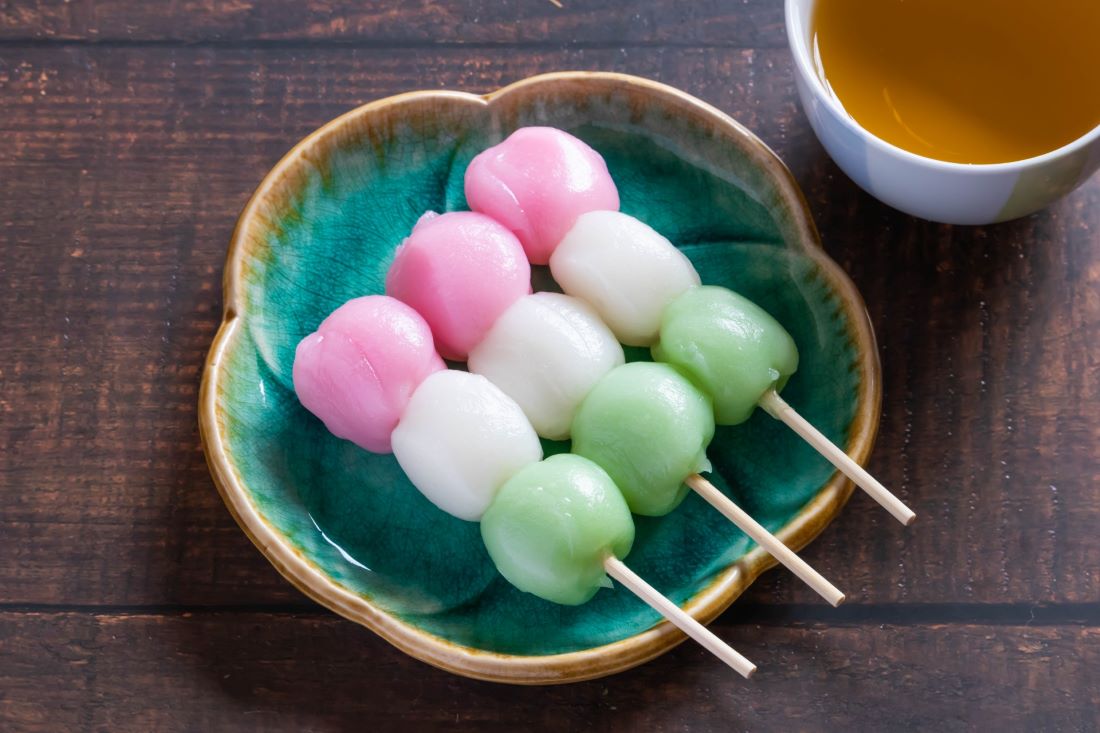Dango is a traditional Japanese sweet treat that has been enjoyed for centuries. Made from rice flour and often served on a skewer, dango is a popular snack that can be found in many Japanese restaurants and food stalls. There are many different variations of dango, each with its own unique flavor and texture.

While dango is a beloved treat in Japan, it is also gaining popularity in other parts of the world. Many people are drawn to dango’s simple yet delicious taste, as well as its unique presentation on a skewer. Whether you are a fan of Japanese cuisine or simply looking for a new and exciting snack to try, dango is definitely worth checking out.
Key Takeaways
- Traditional Japanese sweet treat made from rice flour.
- Often enjoyed during Japanese festivals and celebrations.
- The three most common types of dango are Mitarashi dango, Hanami dango, and Kusa dango.
- Dango is typically gluten-free and vegan-friendly.
Origins

Dango is a traditional Japanese sweet that has been enjoyed for centuries. The exact origin of dango is unclear, but it is believed to have been introduced to Japan during the Jomon period (10,000-300 BCE). The dessert was originally made by grinding nuts into a fine meal, combining them with rice porridge, and molding them into balls.
During the Heian period (794-1185), dango was mentioned in a poem by the famous Japanese poet, Sei Shonagon. It was also during this time that dango began to be served on skewers, a practice that continues to this day. The skewered dango pieces are known as kushi-dango and are usually served in groups of three to five.
Over time, dango became a popular snack food in Japan, and regional varieties and unique flavors began to emerge. Today, dango can be found in many different shapes and sizes, and is often served at festivals and other special occasions.
Varieties

Dango is a sweet Japanese dumpling made from rice flour. There are many varieties of dango, each with its unique flavor and texture. Here are some of the most popular types of dango:
- Mitarashi dango: These are the most popular type of dango in Japan. They are made with a sweet soy sauce glaze and are often served at festivals.
- Anko dango: These dango are filled with sweet red bean paste. They are often served with green tea.
- Sanshoku dango: These dango are made with three colors: pink, green, and white. The pink color comes from plum, the green from mugwort, and the white from plain rice flour.
- Yomogi dango: These dango are made with yomogi (Japanese mugwort) and have a green color. They have a slightly bitter taste and are often served with sweet soy sauce.
- Ume dango: These dango are made with umeboshi (pickled plum) and have a pink color. They have a sour taste and are often served with green tea.
- Kusa dango: These dango are made with Japanese mugwort and have a green color. They have a slightly bitter taste and are often served with sweet soy sauce.
These are just a few of the many varieties of dango available in Japan. Each region of Japan has its unique style of dango, and some dango makers use natural ingredients to achieve the desired colors and flavors. Dango is a popular snack in Japan, and it is often served at festivals and other special events.
Ingredients

Dango is a traditional Japanese sweet made with glutinous rice flour. There are different types of Dango, and the ingredients can vary depending on the recipe. However, the basic ingredients needed to make Dango are:
- Glutinous rice flour – also known as sweet rice flour, this is the main ingredient in Dango. It is what gives Dango its chewy texture.
- Water – hot water is used to create the dough for the Dango.
- Sugar – this is optional, but it can be added to the Dango dough to make it slightly sweet.
Depending on the type of Dango you want to make, you may also need additional ingredients such as:
| Type of Dango | Additional Ingredients |
|---|---|
| Hanami Dango | Matcha powder and pink food coloring |
| Anko Dango | Anko (sweet red bean paste) |
| Kibi Dango | Millet flour |
It is important to note that the ratio of ingredients may vary depending on the recipe. It is recommended to follow the recipe closely to ensure the best results.
Preparation
Dango is a traditional Japanese sweet made from mochiko (sweet rice flour). It is a simple dessert that is easy to make at home. Here are the steps to prepare dango:
Ingredients:
- 1 cup mochiko (sweet rice flour)
- 1/4 cup sugar
- 1/2 cup hot water
- Food coloring or flavoring (optional)
Instructions:
- In a mixing bowl, combine the mochiko and sugar.
- Add hot water to the bowl, little by little, and mix with your hands until the dough has the same consistency as an earlobe.
- Divide the dough into small portions and shape them into balls. You can use food coloring or flavoring to add some variety to your dango.
- Boil a pot of water and drop the dango balls into the water. Cook for about 2-3 minutes or until they float to the surface.
- Remove the dango balls from the water and place them in a bowl of cold water to cool down.
- Thread the dango balls onto skewers and serve.
It is important to note that the consistency of the dough is crucial in making dango. Too much water will result in a sticky and soft dough, while too little water will make it dry and crumbly. So, it is recommended to add hot water little by little and mix with your hands until you reach the desired consistency.
Additionally, you can experiment with different flavors and colors by adding food coloring or flavoring to the dough. Some common flavors include matcha, strawberry, and black sesame.
Serving

Dango is typically served as a sweet treat or dessert in Japan. The most common way of serving dango is in a skewer of 3 to 5 small round dumplings. These skewered dango pieces are called kushi-dango. Mochi can also be formed into a bigger ball stuffed with fillings or formed into a flat round shape coated with seasonings. Both dango and mochi can be plain tasting with a mild rice flavor.
it is often served during special occasions, such as cherry blossom viewing parties (hanami) in the spring, and is a popular snack at street food stalls and festivals. Dango can also be found in Japanese convenience stores and supermarkets.
Some popular toppings include sweet soy sauce (mitarashi), red bean paste (anko), and kinako (roasted soybean flour). These toppings can be drizzled over the dango or used as a dipping sauce.
Dango should be soft and chewy, and can be served at room temperature or slightly chilled. If serving chilled, it is recommended to wrap the dango in plastic wrap to prevent them from drying out.
Popularity

It is a popular snack that can be found in many different regions of Japan, each with their own unique twist on the traditional treat. The popularity of dango has spread beyond Japan’s borders, and it can now be found in various parts of the world.
One reason for the popularity of dango is its versatility. It can be served in a variety of ways, including skewered, boiled, grilled, or fried. It can also be served with various toppings, such as sweet soy sauce, kinako (roasted soybean flour), or anko (sweet red bean paste).
Another reason for dango’s popularity is its wide range of flavors. There are many different types of dango, each with its own unique flavor profile. Some of the most popular types of dango include:
- Denpun dango
- Sasa dango
- Uroko dango
- Hanami dango
- Ikinari dango
- Bocchan dango
- Goma dango
- Kibi dango
These different types of dango are sorted by popularity on various food websites, and each has its own unique flavor and texture. Some are sweet, while others are savory. Some are soft and chewy, while others are firm and crunchy.
Overall, dango’s popularity can be attributed to its delicious taste, versatility, and wide range of flavors. Whether you’re in Japan or abroad, you’re sure to find a dango that suits your taste buds.



